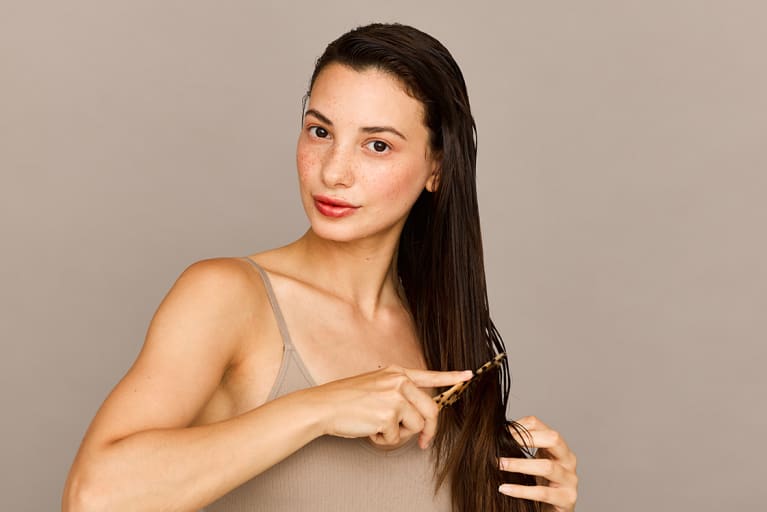
August 29, 2022 — 12:28 PM
Have you ever rinsed out your shampoo to see more than a few strands go down the drain? While it’s easy to jump to conclusions when this happens, you should find peace knowing that each person does lose 50 to 100 hairs a day on average. So a few hairs is to be expected—even if it looks daunting.
However, continuously pulling out clumps of hair or finding thin patches should raise a red flag. In general, hair loss and hair shedding refer to different things and call for different treatments—here’s how to spot the difference.
Hair shedding vs. hair loss—are they different?
“Hair shedding refers to a condition known as telogen effluvium, when the hair sheds more than usual,” board-certified dermatologist Marisa Garshick, M.D., FAAD, tells mbg. “On the other hand, hair loss often refers to a state when something stops the hair from growing,” Garshick says.
So while these terms may be used interchangeably in casual conversation, they’re actually referring to completely different things.
As mentioned above, 50 to 100 hairs a day is a normal range of shedding. So if you pull out a few hairs when you rinse out your shampoo or run a brush through your strands, there’s no reason to panic.
Once you begin to lose substantially more hair throughout the day, you may be experiencing excessive shedding. As Garshick says, “Excessive hair shedding may occur as a result of certain physical, emotional, or psychological stressors on the body.”
The shedding generally occurs six to 12 weeks after a distressing event or time period, says consultant trichologist Anabel Kingsly.
Why might you be shedding more than normal?
According to Garshick and Kingsly, few of the common stressors that may trigger excessive shedding include:
- Weight loss
- General illness
- Change in diet
- New job
- Divorce
- Pregnancy or delivery
- Death of a loved one
- Hormonal contraceptives
- Emotional shock or trauma
- Iron deficiency
- Stress
- Seasonal changes (late summer to fall especially)
beauty & gut collagen+
A powerful daily ritual for glowing skin and strong hair & nails*

Increased hair shedding can quickly lead to hair loss, so it’s important to keep a mental note of how much hair you’re losing if you suspect an increase in shedding. Every time you feel a clump of hairs come out, take note of about how many and what triggered the hairs to come loose.
For example, ask yourself: Were you pulling on your hair? Just brushing through it? Maybe rinsing out your conditioner? Over time this will provide insight into your hair shedding patterns.
An additional caveat: If you don’t brush or wash your hair daily (like many with curly hair don’t), you may notice much more hair than 50 to 100 stands once you do brush or wash your hair. This is because the hairs that were supposed to shed naturally day-by-day collect until you detangle the strands. Just another thing to keep in mind as you are tracking your shedding patterns.
Hair loss is much more serious than hair shedding. Unfortunately, it can be difficult to determine what’s causing hair loss given that there are a few different types and tons of contributing factors. Below, a few common forms of hair loss:
- Androgenetic alopecia: This refers to a form of predetermined hair loss due to an excessive response to androgens. Garshick explains that this form of hair loss may be associated with general hormonal changes as well. Up to 50% of males and females experience this kind of hair loss in varying degrees.
- Alopecia areata: This refers to baldness in patches, typically found on the top of the head. This can also be tied to genetic patterns, though this form of hair loss won’t necessarily be passed down through genes every time.
- Traction alopecia: This form of hair loss is caused by hairstyles (like tight ponytails, braids, and buns) that pull on the hair causing targeted hair loss over time. Styles like slicked-back buns and ponytails can not only cause hair loss where the hair elastic is attached but also around the face because the hair is pulled back so tightly.
As you can see, there isn’t just one type of hair loss. Each form calls for different treatments and interventions, so it’s extremely important to identify the root cause of the hair loss; otherwise, you’ll be chasing a solution to a problem you may not even have. “For example, if your hair loss is not due to a nutritional deficiency, then taking a nutritional supplement isn’t going to be effective,” Kingsley explains.
A few common causes of hair loss include:
- Genetic predisposition
- Age
- Immune system complications
- Cancer treatment
- Childbirth
- Illness
- Tight hairstyles
- Damaging hair care (excess perms, relaxers, or coloring)
- Hormonal imbalance
- Scalp infection
- Scalp psoriasis
- Untreated sexually transmitted infections (STIs)
- Too little biotin
How to reduce hair shedding and loss.
If you are experiencing shedding or loss, there are steps you can take to address the issue:
Keeping up with regular scalp care is essential to encourage growth and reduce hair shedding and loss. As a rule of thumb, treat your scalp more like your face than you do your strands—exfoliate weekly and always replenish hydration.
In addition, you may consider adding a nutrient-rich serum to the mix. There’s a plethora of hair growth serums on the market—here are a few of our top picks to get you started.
Scalp massages may seem like a pure indulgence, but studies have shown that this practice can significantly affect the health of your scalp and, in turn, improve the appearance of your hair as well.
In fact, in a 2016 study, a small number of men received a daily four-minute scalp massage. At the conclusion of the study, the investigators found an increase in hair thickness. A more recent 2019 study found that of the 300 or so participants who followed a specific massage regimen, nearly 70% reported improved hair thickness at the end.
If you want to learn more about the ins and outs of scalp massage, including the how-to, check out this story.
Obviously, this is much easier said than done. However, focusing on reducing stress in your day-to-day life will help decrease stress-induced shedding (and better your overall well-being). How you choose to blow off steam will naturally depend on your lifestyle, schedule, and what brings you joy.
Here are 10 natural ways to reduce stress to get you brainstorming.
As we mentioned earlier, too little biotin can cause scalp complications and lead to hair loss among other problems. While you can take isolated biotin supplements, there’s plenty of combination supplements on the market for healthy hair, skin, and nails that may do the trick and make your investment worthwhile.
Here, the six best hair growth vitamins, according to a scalp expert.
If you’re not sure what’s causing your hair loss, it’s best to visit a professional before committing to one mode of treatment. Head to your dermatologist or your local trichologist to get to the bottom of it. Not to mention, Kingsley explains, “Knowing what you are dealing with has a huge impact on decreasing the stress and worry.”
These experts will likely look into your medical and genetic history, evaluate your diet and lifestyle, check up on your hair and scalp condition, and possibly even test your blood to figure out what factors may be influencing your hair loss.
Hair loss and hair shedding are very different, even if they’re frequently used interchangeably in conversation. Daily light shedding is to be expected, but an increase in shedding may be something you want to look into as it can quickly lead to hair loss—another condition with a long list of causes and treatments. If you’re unsure if you’re experiencing hair loss of some sort, consult a dermatologist or trichologist to get an evaluation. Regardless of what’s going on with your hair, tending to the scalp is never a bad idea—here’s everything you need to know about scalp care.
Heal Your Skin.
Receive your FREE Doctor-Approved Beauty Guide
You are now subscribed
Be on the lookout for a welcome email in your inbox!
https://www.mindbodygreen.com/articles/hair-shedding-vs-hair-loss-how-to-spot-difference

